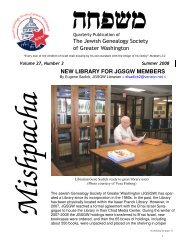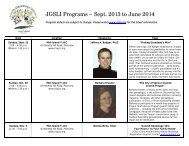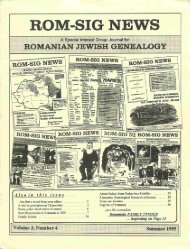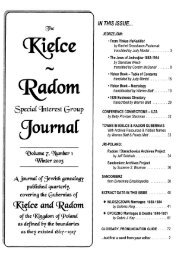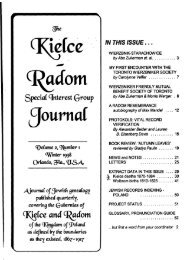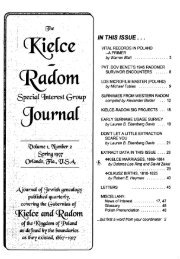THE MEMORIAL BOOK OF PÁPA JEWRY - JewishGen
THE MEMORIAL BOOK OF PÁPA JEWRY - JewishGen
THE MEMORIAL BOOK OF PÁPA JEWRY - JewishGen
You also want an ePaper? Increase the reach of your titles
YUMPU automatically turns print PDFs into web optimized ePapers that Google loves.
with D'Annunzio, which was not approved of by the citizens of the town. One day Shisha was<br />
kidnapped from his apartment at gun-point by reactionaries; he was forced into a car, and was<br />
driven away. D'Annunzio was informed about it, saved Shisha's life, and advised him to leave the<br />
town. First, he worked in the organisation of the Italian Socialist Party in Civita Vecchia, and<br />
then he moved to Rome where he worked as an official in charge of the press for the Soviet<br />
Embassy. In 1927 he was transferred to Milano where he fell mortally ill, and died there at the<br />
age of 34 on July 13, 1927.<br />
Dr. Miklós Shisha was an idealist with a pure soul and an amazingly intelligent person.<br />
His attitude to being a Jew is demonstrated in his letters written to his brother who settled in<br />
Palestine in 1920. He was not religious, but he was a self-respecting Jew who never denied his<br />
identity.<br />
He highly valued the building of Eretz Yisrael. In his letters, he drew a parallel between<br />
his humanistic socialism and Zionism which was building the country. He yearned to see Eretz<br />
Yisrael being rebuilt, but his dream could not be realized. Fate decided otherwise. The fact that<br />
the builders of the new world highly appreciated the activities of Dr. Shisha is attested by the<br />
following books written about him:<br />
1.Galilei per a XX. században [The Trial of Galilei in the 20th century] by Jolán Kelen,<br />
Kossuth, 1957.<br />
2.Új vizeken járok. A Galilei Kör története [I Walk on New Waters. The History of the<br />
Galilei Circle] by Márta Tömöry, Gondolat, Budapest, 1960.<br />
3.Sisa Miklós. ‘Forrás’, Irodalom, Művészet, Tudomány by Nándor Heltai, Kecskemét,<br />
July 1969.<br />
ALBERT SHELLEY<br />
Albert Seelenfreund, born in Pápa, was a later successor of the Abaújszántó rabbi Shemen<br />
Rokeach. He was a student in the days of Herzl when he founded the Tzeirei Tzion Youth<br />
Association in Pápa. He received his diploma as a teacher and a chazan at the National Teacher<br />
Training College of Pápa with an excellent record. He was a student at the Teacher Training<br />
College and only 19 when, in recognition of his talents, he was invited by the Szeged Jewish<br />
Community to take the post of secretary. Chief Rabbi Immanuel Lőw loved this musical genius,<br />
whose pleasant baritone voice elevated the ritual of the priestly blessing (Albert was a Cohen) to<br />
an artistic level. While working as secretary at Szeged, several of his poems were published in the<br />
most intellectual Jewish periodical, Múlt és Jövő, under the name Albert Baráth. During the First<br />
World War, in which he was injured, he reached the rank of lieutenant. After the war, he returned<br />
to Szeged. He left his secretarial job and worked for a wholesale business firm where he was in<br />
charge of exporting paprika<br />
Many years before the Second World War, he travelled with his family to Cuba, then to<br />
Mexico, and soon won himself a name as the representative of chemical factories. A series of his<br />
articles were published in Spanish in the technical literature. He was in charge of the temple<br />
frequented by Hungarians in Mexico City, and his holiday sermons were the highlights of the<br />
services.<br />
On the occasion of his 70th birthday, he visited Israel and presented the Bnei Herzl Lodge<br />
with a beautiful silver goblet in memory of Immanuel Lőw.<br />
101



